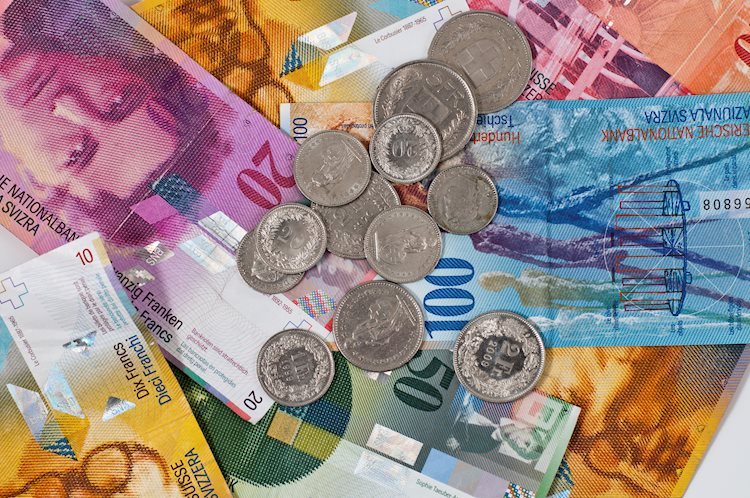- USD/CHF falls back from 0.8700, following the US Dollar’s retreat.
- This week, the US Dollar will be guided by a slew of US economic data.
- Swiss Franc bulls will strengthen after a Bullish Flag breakout.
The USD/CHF pair falls sharply after testing the round-level resistance of 0.8700 in Monday’s European session, the highest level seen in more than two months. The Swiss Franc pair traced the US Dollar’s (USD) move, which retreated after revisiting an almost three-month high, with the US Dollar Index (DXY) falling from 104.60.
The US Dollar struggles to extend its upside move as investors turn cautious with an array of United States (US) economic data in the pipeline. This week, market participants will focus on the Q3 Gross Domestic Product (GDP), the Personal Consumption Expenditure Price Index (PCE) for September, and the Nonfarm Payrolls (NFP) for October, which will influence market speculation for Federal Reserve (Fed) interest rate path.
Signs of significant job demand and economic growth will weaken the Fed dovish bets for the December meeting as traders have priced in a 25 basis points (bps) interest rate cut in November. On the contrary, soft numbers would do the opposite. Meanwhile, a majority of Fed officials are confident that the disinflation trend is intact towards the bank’s target of 2%.
In the Swiss region, market participants expect the Swiss National Bank (SNB) to continue reducing interest rates further as inflationary pressures remain within striking distance of 2% for a longer period.
USD/CHF forms a Bullish Flag chart pattern on a daily timeframe. The above-mentioned pattern reflects an inventory adjustment process that follows the ongoing trend after the completion, which in this case is up.
Upward-sloping 20-day Exponential Moving Average (EMA) near 0.8613, suggests a strong uptrend.
The 14-period Relative Strength Index (RSI) oscillates in the bullish range of 60.00-80.00, indicating a strong upside momentum.
More upside would appear if the Swiss Franc pair breaks above the intraday high of 0.8700. A breakout move will drive the asset towards the August 15 high of 0.8750 and the July 25 low of 0.8777.
In an alternate scenario, a downside move below the September 12 low of 0.8550 will drag the asset toward the psychological support of 0.8500, followed by the October 2 low of 0.8450.
USD/CHF daily chart
Swiss Franc FAQs
The Swiss Franc (CHF) is Switzerland’s official currency. It is among the top ten most traded currencies globally, reaching volumes that well exceed the size of the Swiss economy. Its value is determined by the broad market sentiment, the country’s economic health or action taken by the Swiss National Bank (SNB), among other factors. Between 2011 and 2015, the Swiss Franc was pegged to the Euro (EUR). The peg was abruptly removed, resulting in a more than 20% increase in the Franc’s value, causing a turmoil in markets. Even though the peg isn’t in force anymore, CHF fortunes tend to be highly correlated with the Euro ones due to the high dependency of the Swiss economy on the neighboring Eurozone.
The Swiss Franc (CHF) is considered a safe-haven asset, or a currency that investors tend to buy in times of market stress. This is due to the perceived status of Switzerland in the world: a stable economy, a strong export sector, big central bank reserves or a longstanding political stance towards neutrality in global conflicts make the country’s currency a good choice for investors fleeing from risks. Turbulent times are likely to strengthen CHF value against other currencies that are seen as more risky to invest in.
The Swiss National Bank (SNB) meets four times a year – once every quarter, less than other major central banks – to decide on monetary policy. The bank aims for an annual inflation rate of less than 2%. When inflation is above target or forecasted to be above target in the foreseeable future, the bank will attempt to tame price growth by raising its policy rate. Higher interest rates are generally positive for the Swiss Franc (CHF) as they lead to higher yields, making the country a more attractive place for investors. On the contrary, lower interest rates tend to weaken CHF.
Macroeconomic data releases in Switzerland are key to assessing the state of the economy and can impact the Swiss Franc’s (CHF) valuation. The Swiss economy is broadly stable, but any sudden change in economic growth, inflation, current account or the central bank’s currency reserves have the potential to trigger moves in CHF. Generally, high economic growth, low unemployment and high confidence are good for CHF. Conversely, if economic data points to weakening momentum, CHF is likely to depreciate.
As a small and open economy, Switzerland is heavily dependent on the health of the neighboring Eurozone economies. The broader European Union is Switzerland’s main economic partner and a key political ally, so macroeconomic and monetary policy stability in the Eurozone is essential for Switzerland and, thus, for the Swiss Franc (CHF). With such dependency, some models suggest that the correlation between the fortunes of the Euro (EUR) and the CHF is more than 90%, or close to perfect.
Read the full article here

